NAKED LUNCH (1991)
After developing an addiction to the substance he uses to kill bugs, an exterminator accidentally kills his wife and becomes involved in a secret government plot orchestrated by giant bugs.
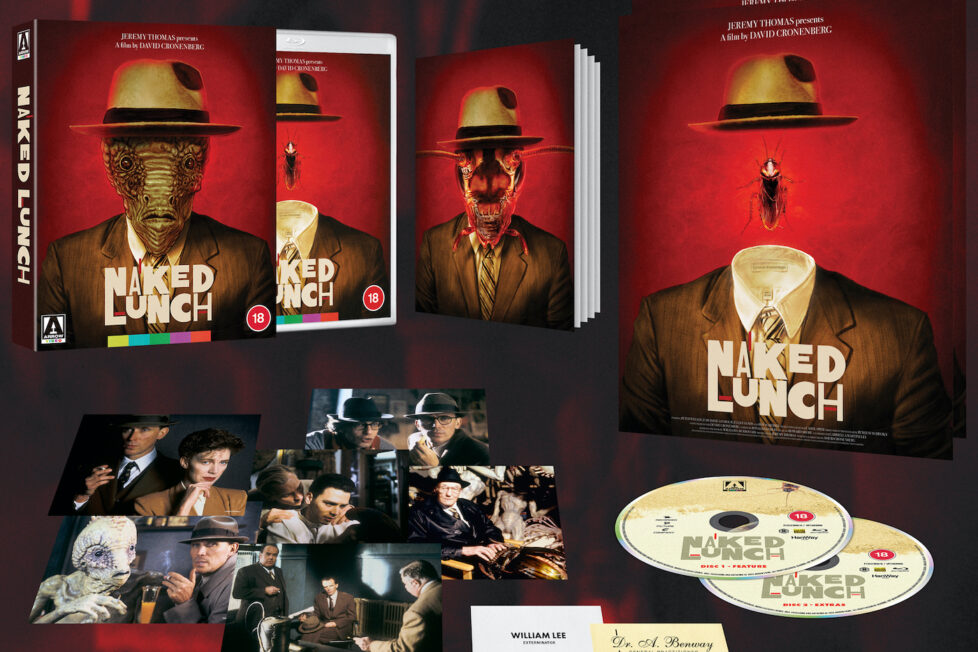
After developing an addiction to the substance he uses to kill bugs, an exterminator accidentally kills his wife and becomes involved in a secret government plot orchestrated by giant bugs.


Alongside Jack Kerouac and Allen Ginsberg, William S. Burroughs was a key figure of the Beat Generation. During the 1950s and 1960s, such writers were instrumental in reshaping America’s literary landscape with their spontaneous prose and rebellious mindset facilitating the counterculture movement that followed. After recovering from his 15-year drug addiction, Burroughs released his third and most popular novel, Naked Lunch—an existential travelogue of sexual obsession, outlandish government conspiracies, and even stranger medical experiments. The book garnered glowing and impassioned reviews from critics and audiences alike for its provocative portrayal of substance abuse. However, Burroughs’ unapologetic obscenity earned the attention of the legal system, and Naked Lunch was banned for years. This decision was eventually overturned and ultimately had a profound effect on laws regarding the legality of sexually explicit material.
Numerous filmmakers, including Anthony Balch (Secrets of Sex) and Dennis Hopper (Easy Rider), considered adapting the novel. However, all were stymied by Burroughs’ elliptical writing, but the paranoia and rejection of humanism found within Burroughs’ text were embraced by writer-director David Cronenberg. The Canadian filmmaker’s preoccupation with sexual fluidity in Rabid (1977), the lethal telepathic practices of Scanners (1981), and the visceral marriage of flesh and technology in Videodrome (1983) were all influenced by Naked Lunch.
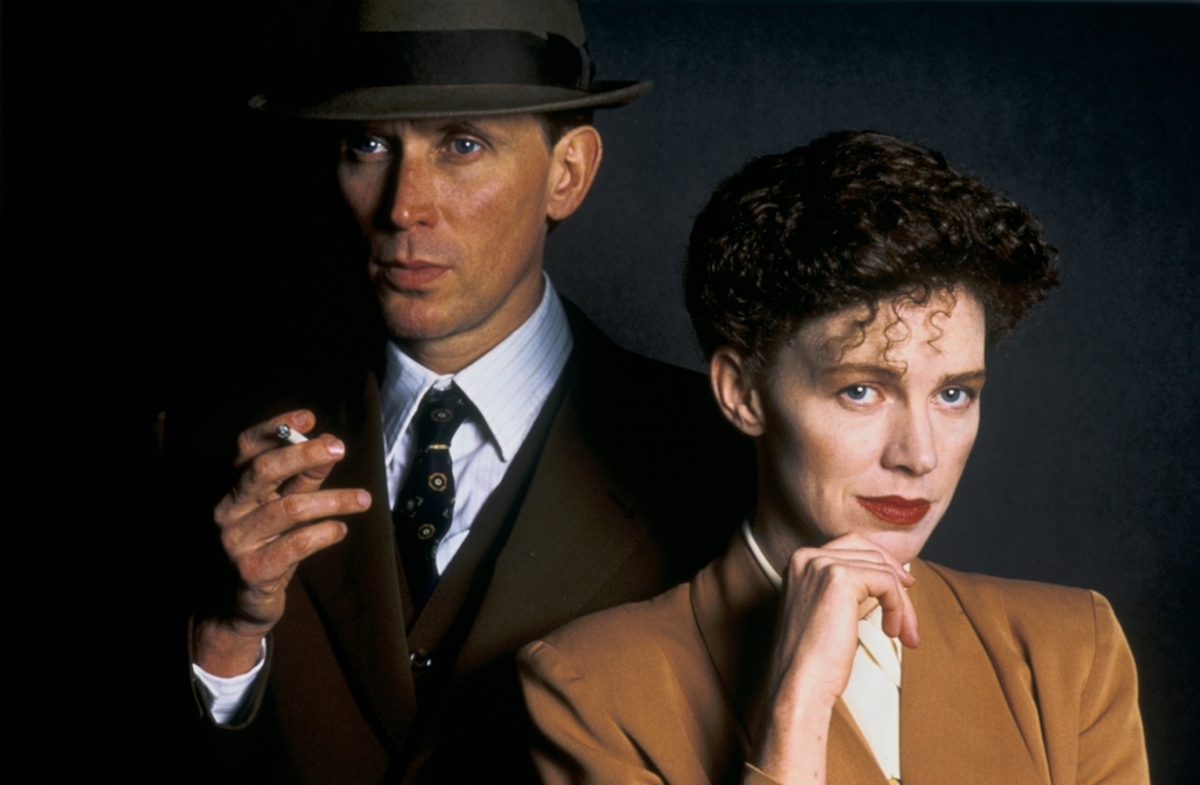
Cronenberg had considered adapting it since the early-1980s, despite it long being considered impossible to film. But then, following the release of Dead Ringers (1988), he finally got an opportunity after producer Jeremy Thomas (The Last Emperor) purchased the rights and paid for development expenses—eventually sinking an estimated $16M into the project. The result is significantly different than Burroughs’ meanderings and, whether that betrays the novel or not, continues to be debated. Regardless, Naked Lunch allowed Cronenberg to find interesting avenues to explore while freely incorporating his own fascinations into the mix.
William “Bill” Lee (Peter Weller) is an exterminator and former addict working in New York City in 1953. After discovering his wife Joan (Judy Davis) is stealing big powder to use as a recreational drug, he finds himself arrested for possession of an illegal substance. They introduce him to a gigantic insect who convinces Bill he’s an agent for the nefarious corporation Interzone Incorporated. As the situation escalates and he becomes embroiled in a conspiracy between two rival organisations, Bill flees to a distant North African city known as “The Interzone”. While continuing his secret mission, Bill begins writing reports about the sale of an addictive narcotic produced in “The Interzone” and, during his journey, Bill’s typewriter transforms into a giant creature seemingly hellbent on making him question his own sexuality. Amidst this world of government conspiracies, corrupt doctors, sadistic hedonists, and grotesque creatures, Bill’s reports begin to coalesce into a strange masterpiece. However, in order to complete his novel, Bill may have to risk his life, sanity, and sense of identity itself.
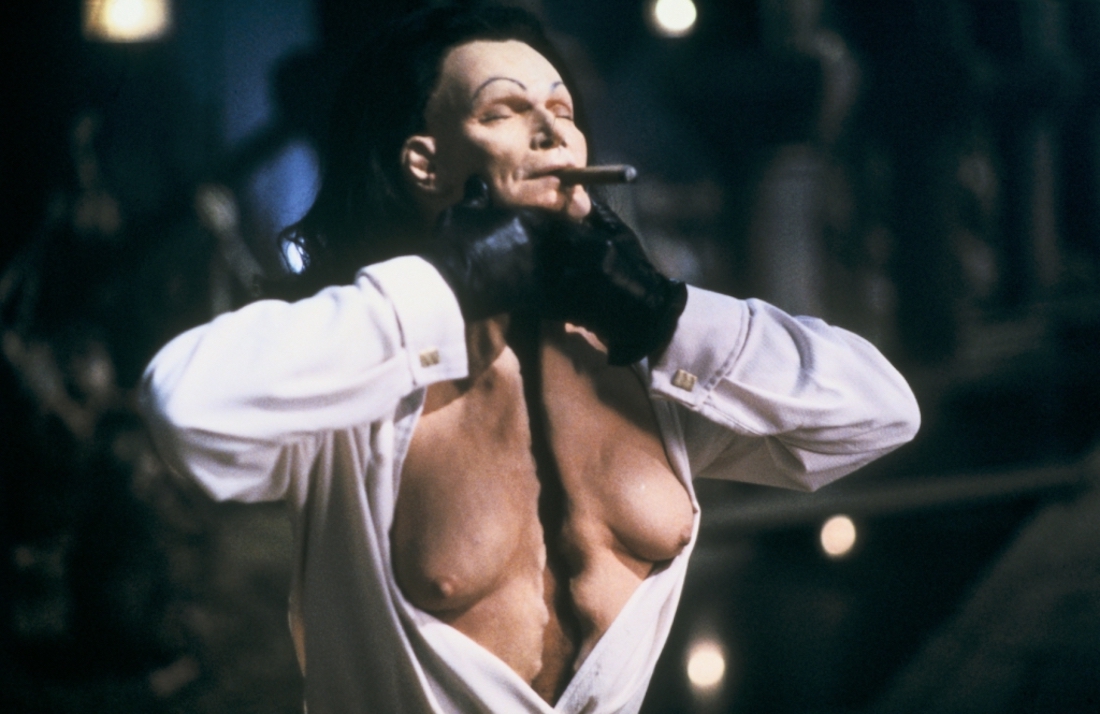
After cementing his Hollywood legacy as Alex Murphy in RoboCop (1987), Peter Weller continued to demonstrate his versatility here. He delivers a marvellously reserved performance as Burroughs’ surrogate, William “Bill” Lee. The character requires a specific emotional duality and Weller perfectly portrays Bill’s disconnection from the world. His stoic demeanour suggests he’s become so habituated with drugs that he’s forgotten how to function without them. As the world around him dissolves into that of “The Interzone”, he becomes a slave to his addiction. Unlike Ben Fosters’s characterisation in Kill Your Darlings (2013), Weller never overstates his despair and sudden reawakening. He remains an enigmatic figure who is haunted by his own hallucinations. The brilliance of his performance is within the sense of internalised complexity behind his impenetrable gaze. It’s a nuanced turn, but despite his radical actions, the character never loses the audience’s sympathy. It’s a remarkable transformation of the actor and arguably one of his best.
Although it was considered impossible to film, Naked Lunch reveals itself to be an intelligent piece of filmmaking when exploring the screenplay. In the book Cronenberg On Cronenberg, the filmmaker stated that a literal adaptation would have “cost $400 million to make and would be banned in every country in the world.” The source material is a searing evocation of Burroughs’ sexuality and psychology. While transitioning unannounced between hallucination and consensus, it examines the impulses and neuroses that motivated his life. Interestingly, Cronenberg incorporates biographical elements into his screenplay to reinforce abstract parts of Burroughs’ own experiences to help reveal the truth of his character. We see Bill working as an exterminator in NYC and witness the accidental death of his wife during a William Tell Routine. Whereas many well-known friends and associates of the author such as Jack Kerouac (Nicholas Campbell) and Allen Ginsberg (Michael Zelniker) are depicted. However, Cronenberg wisely removes Burroughs’ explicit acts of homosexual paedophilia. One should view Naked Lunch as a fragmented biopic with elements of the novel added to represent the perpetual haze in which Burroughs spent the majority of his life. While Cronenberg’s script is every bit as impenetrable as the source material, the filmmaker has certainly created something more digestible.
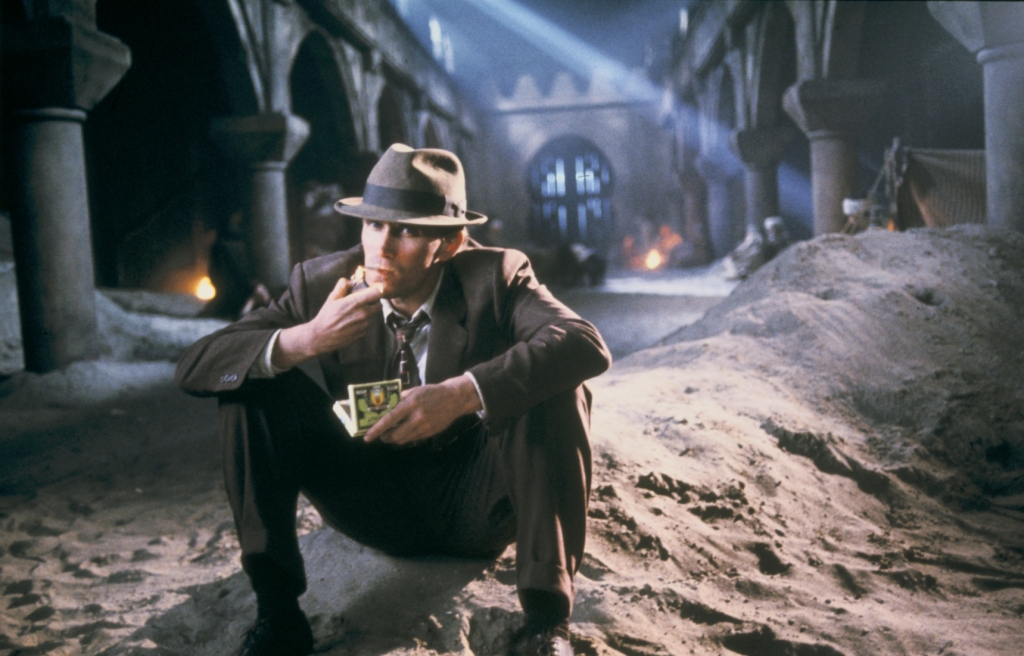
Concentrating on the hallucinogenic experience that colours Burroughs’ writing, Cronenberg’s fictionalised biopic echoes Fear and Loathing in Las Vegas (1998). Audiences paying attention will understand this is the imagination of an addict and the locations can be interpreted as an alternate state. “The Interzone” appears to be Tangier or Morocco but bears similarities to Jean Cocteau’s La Zone (1950) and Jean-Luc Godard’s Alphaville (1965). There’s a lurid richness to the world presented and Peter Suschitzky’s (Dead Ringers) cinematography matches the self-prioritising excesses of its characters. The score only adds to the collision of varying sensibilities of sickly uneasiness. Provided by frequent collaborator Howard Shore (Crimes of the Future) and jazz musician Ornette Coleman, Cronenberg uses the soundscape to pay homage to the influence of jazz improvisation on the Beat movement. Alternating between dizzying saxophones and brooding cues much like Angelo Badalamenti’s scores for Twin Peaks: Fire Walk With Me (1992), it indicates a darker truth awaiting Bill. It’s beautifully surreal how Cronenberg interprets the hallucinogenic world with an ambience as audacious as Burroughs is on the page.
There’s a synergistic marriage between Cronenberg’s macabre and Burrough’s own cocktail of sexual depravity and bodily transformation. The pioneer of ‘venereal horror’ lifts the literary iconography and provides plenty of creature effects that are profoundly disorienting and repulsive. Similar to The Fly (1986), it’s a world of hideous transformations where inanimate objects morph into disgusting creatures. Gigantic Mugwumps secrete obscene but intoxicating substances from various parts of their anatomies. Whereas a giant cockroach metamorphoses out of Bill’s typewriter, revealing a mouth shaped like a certain unmentionable human orifice. The lasting impact of these disturbing images is made possible by Chris Walas’s (Gremlins) wonderful SFX. The pinnacle of this grotesque imagery arrives when a monstrous colossal centipede is sodomising a young philanderer. There are plenty of sequences that many viewers will find more challenging than titillating. However, audiences with a predisposition toward Cronenberg’s body horror will find Naked Lunch amusing in a perverse sense.
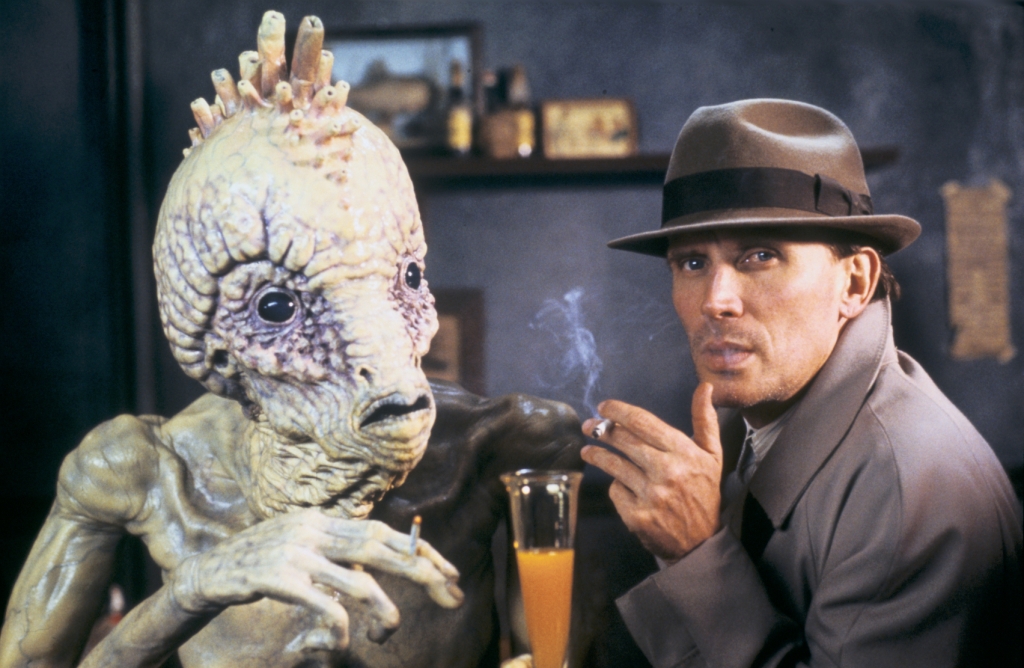
While Naked Lunch can be enjoyed purely on a visual level, Cronenberg attempts to reveal the novel’s taboo subtext including polymorphous perversion and latent homosexuality. During his early writing career, Burroughs was ashamed of his own sexuality and blamed his addictions and neuroses for his homosexual impulses. As the filmmaker mentions about the author, “he felt that by writing ‘Naked Lunch’ he had cured himself of his homosexuality”. Bill’s descent into addiction is presented as an escape from admitting his own nature. Although not overtly expressed it’s suggested that his wife’s unfortunate death presents a chance for Bill to accept himself and his sexuality. After creating the government conspiracy and fleeing to “The Interzone”, Bill’s typewriter reveals itself as his employer. Determined to make him question his own sexuality, it says “Homosexuality is the best all-around cover an agent ever had”. It’s a surreal expression of a man at war with his own identity and Cronenberg’s approach is rather ambiguous. However, it’s an interesting portrayal of the complexity and anguish many Beats reportedly felt about their own sexuality.
Cronenberg’s approach to Naked Lunch isn’t a straightforward adaptation of Burroughs’ novel. It’s an amalgamation of certain events and texts from the author’s life combined with the filmmaker’s idiosyncrasies. Audiences expecting a faithful adaptation of the famous novel may be disappointed. However, it’s intellectually stimulating and held together with exhilarating performances and stylish direction. Unfortunately, it was criminally undervalued by the studio and only grossed $2.6M commercially. However, it’s since garnered a cult following because of its unusual subject matter and incoherent structure. Admittedly, several moments cross the boundaries of good taste but there’s no denying Cronenberg had an impressive knack for disgusting his audiences.
CANADA • UNITED KINGDOM • JAPAN | 1991 | 115 MINUTES | 1:85:1 | COLOUR | ENGLISH • ARABIC

Continuing their relationship with David Cronenberg following the re-release of Videodrome and Crash (1996), Naked Lunch has been given a wonderful 4K restoration courtesy of Arrow Video. Showcasing an immaculate 2160p Ultra HD transfer, the image was sourced from the original 35mm camera negative and supervised by the cinematographer Peter Suschitzky and approved by Cronenberg.
Captured primarily on Panavision cameras, the beautifully rich image is presented in its original aspect ratio of 1:85:1. The levels of detail are sublime and viewers will appreciate the transfer’s ability to clearly showcase even the finest textures. Individual patterns and clothing threads are discernible in different lighting conditions. Whereas the subtle patterns including cigarette ash, wood grain, and centipede legs appear naturally sharp and stable across the entire frame.
Flesh tones appear natural and facial complexions appear visible, revealing the finest blemishes and beads of sweat on Bill’s brow. Despite the rather bland colour scheme, the Dolby Vision colour grading intensifies the palette as much as possible. Focussing primarily on golden browns and earthy yellows, it’s wonderfully reproduced. Whereas primaries are well saturated with blue skies and crimson reds receiving a healthy boost. The film grain is beautifully rendered and there aren’t any noticeable noise fluctuations throughout. There are no serious stability issues to report with damage marks and debris having been removed as best as possible. Overall, the picture enjoys a substantial improvement and looks considerably better than the 1080p version.
The 4K Ultra HD release of Naked Lunch features two audio tracks with optional English Subtitles. Arrow Video provides a DTS-HD 2.0 stereo and an immersive DTS-HD 5.1 Master Audio. Although the DTS-HD 2.0 track prioritises the dialogue, there’s a surprising amount of dynamic to the midrange. Whereas the DTS-HD 5.1 mix sweeps the soundstage beautifully heightening the unnerving atmosphere. The dialogue is effectively discernible and dispersed primarily at the front to allow the surrounding channels to really open up the sound field.
The music is certainly a highlight and a necessary ingredient for shaping the viewer’s experience. Howard Shore’s hauntingly hypnotic score and jazz musician Ornette Coleman’s jazz compositions have never sounded better. They’re well-balanced and sweep the soundstage during key moments and complement the action on the screen. It genuinely feels like one is sitting alongside William S. Burroughs and Jack Kerouac at the infamous Royal Roost jazz club. Supporting sound effects create an immersive atmosphere and are nicely implemented through the side and rear channels. The bustling city of New York and Tangier sound incredibly immersive and can be heard in every direction. Subtle atmospherics including distant traffic noises and rattling metals are handled nicely.

director: David Cronenberg.
writer: David Cronenberg (based on the novel “Naked Lunch” by William S. Burroughs).
starring: Peter Weller, Judy Davis, Ian Holm, Julian Sands & Roy Scheider.
